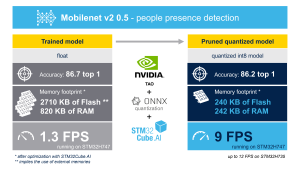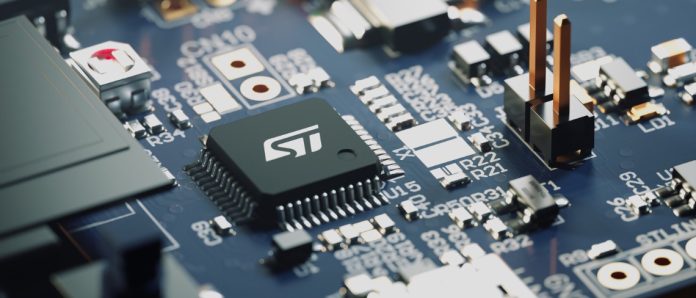Author: STMicroelectronics
Where are embedded systems heading in 2024, and how can makers stay ahead of the curve? Few people used to ask these questions a decade ago. Today, the answers can make or break entire companies. Indeed, once relegated to a few niche applications, embedded systems are now everywhere. From factories to home appliances or from expensive medical devices in hospitals to ubiquitous wearables, every time we become more connected or more sustainable, an embedded system is usually at the heart of innovations. ST will thus hold the STM32 Summit on March 19 to introduce our community to the latest technologies shaping our industry. In the meantime, let’s step back to see where 2024 is taking us.
Computational efficiency or doing more with less
Avid readers of the ST Blog know that greater efficiency is often a key driver of our innovations. However, we may need to broaden our understanding of “efficiency”. In essence, efficiency is the ratio of work done per amount of energy spent. In the microcontroller world, it refers to electrical efficiency. Hence, improving efficiency means lowering the power consumption while offering the same or more computational throughput. However, as embedded systems applications become vastly more optimized, a new efficiency ratio shapes the industry: application complexity for a given computational throughput.
To illustrate this point, let’s use a simple thought experiment. Imagine bringing today’s high-performance MCU back in time just five years ago. That device could not run the neural network or rich UIs it can run today because frameworks and machine learning algorithms were far cruder. The reason is that embedded systems aren’t just more powerful but that new applicative optimizations have made them more capable. Consequently, the same amount of computational power yields far greater results today.

For instance, the quantization of neural networks enabled more powerful edge AI systems. In the case of a recent demo with Schneider Electric, a deeply quantized neural network meant that a people-counting application ran on an STM32H7. And NVIDIA featured the same MCU when running a network optimized with its TAO Toolkit and STM32Cube.AI. Similarly, new motor control algorithms, like ZeST, mean MCUs drive motors more accurately and efficiently, and new UI framework optimizations mean richer graphics while needing less memory. For instance, the latest version of TouchGFX supports vector fonts, and our latest STM32U5 has an IP accelerating vector graphics, which wouldn’t have been as impressive without the graphical framework to help developers take advantage of it.
Consequently, engineers must not only ensure their embedded processing solutions is reducing their power consumption but that it also runs the latest optimizations. In many instances, a real-time application is no longer just basic code running in a while loop. Developers must find new ways to leverage the cloud, machine learning, sensor fusion, or graphical interfaces. Hence, it is critical to find the right MCU supported by an entire ecosystem that can bring these new optimizations to them. Engineers must ask how fast a device runs and how well it can support the complexity and richness of the application.
Multiple wireless protocol support or talking more with the world

The idea that an embedded system connects to a network is far from new. The industry even coined the term “Internet of Things” because so many applications rely on the network of networks. However, until now, applications have primarily chosen one mode of communication, either wired or wireless. And if the latter, it used to settle on one wireless protocol, such as cellular, Wi-Fi, or Bluetooth. Over the years, the industry has seen the multiplication of wireless protocols. From 6LoWPAN to LoRaWAN, Zigbee, Thread, NB-IoT, and more, there’s no shortage of new protocols. Interestingly, there has also been the absence of a clear winner. Instead of a traditional consolidation, many technologies seem to prosper concomitantly.
Let’s take the 2.4 GHz spectrum as an example. While Bluetooth is still dominant, Zigbee and Thread have grown in popularity. Many companies also work on a custom IEEE 802.15.4 protocol for competitive or regulatory reasons. In fact, the proliferation of network protocols is so rampant that Matter, the latest initiative unifying home automation under one standard, runs over multiple wireless technologies like Wi-Fi, Thread, and Bluetooth and supports many 2.4 GHz bridges, including Zigbee and Z-Wave instead of settling on just one wireless technology.
As a result, engineers face a relatively new challenge: create a system that must support multiple wireless protocols to stay competitive. Indeed, by adopting a device that supports multiple technologies, a company can qualify one MCU and adapt to the needs of the market. For instance, a developer could work on a proprietary IEEE 802.15.4 protocol in one region, and then adopt Thread in another while keeping the exact same hardware. It would only require a change to the code base. Engineers would thus reduce their time to market and enjoy far greater flexibility. Put simply, embedded systems developers in 2024 must design with multi-protocol support in mind and choose devices that will meet current and future needs.
Security or protecting future investments

One positive trend in embedded systems has been recognizing that security is not optional. For the longest time, many joked that IoT stood for “Internet of Threats”. Today, developers know it is imperative to protect servers, code, end-user data, and even physical devices from attacks. In a nutshell, a failure to secure an embedded system could have catastrophic effects on the product and its brand. However, a new security challenge has emerged in the form of regulatory interventions. The European Union, the United States, and many other countries and standardizing bodies have enacted new rules mandating features and protections. The problem is that they aren’t always clear or final, as some are still being worked on.
The industry has been answering this new challenge with more formal security standards. For instance, the Platform Security Architecture (PSA) and the Security Evaluation Standard for IoT Platforms (SESIP) certifications offer an extensive methodology to help engineers secure their embedded systems. These certifications thus provide a path to future-proof designs and ensure they meet any stringent requirements. However, it also means that developers can’t treat security as an afterthought or work toward those certifications after designing their system. It is becoming critical to think of security as soon as the first proof of concept and adopt a microcontroller that can meet the proper certification level.
Let’s take the example of a smart home application that shares private and sensitive data with a cloud. Increasingly, governments require encrypted communications, protections against physical attacks, safeguards against software intrusions, the ability to securely update a system over-the-air, and monitoring capabilities to detect a breach. In many instances, a SESIP Level 3 certification would help guarantee that a system could meet those requirements. Unfortunately, engineers who fail to choose an MCU capable of targeting such a certification could end up compromising the entire project. As there are hardware and platform considerations that ensure a product can meet a certain security certification, developers must adopt a new mindset when choosing an MCU.
See what the future holds at the STM32 Summit

As we look at the trends that will shape 2024 and beyond, we see that it is critical to find an ecosystem maker. Computational efficiency depends on the MCU as well as the framework, middleware, and algorithms that run on it. Similarly, supporting multiple wireless protocols demands new development tools, and securing embedded systems requires practical software solutions on top of hardware IPs. That’s why we are excited to host the STM32 Summit on March 19. Join us as we showcase how ST is bringing solutions to help teams stay ahead of upcoming trends.
Viewers will get to learn more about exciting devices that are shaping new trends while also discovering entirely new products. Attendees will also be able to ask questions to ST experts and receive answers live. Registering to this event thus grants unique access to our teams. Moreover, the STM32 Summit will feature some of our customers who will share real-world experiences. Instead of ST telling the industry how to meet the challenges ahead, we wanted our partners to show viewers how they do it. Put simply, the STM32 Summit isn’t only here to inform but to inspire.








